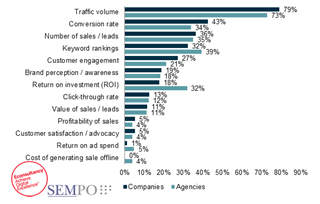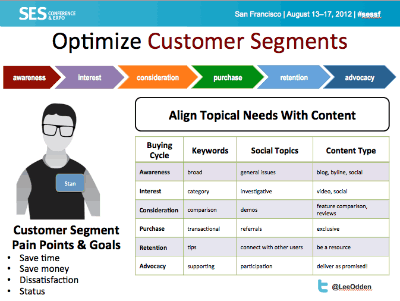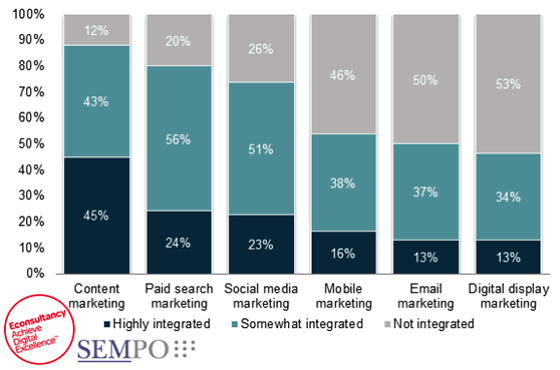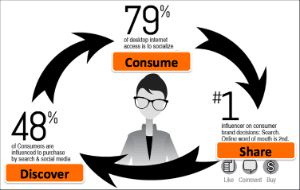Search engine optimization (SEO), along with email marketing, belongs to the oldest digital marketing techniques. Traditionally, search engine optimization was approached as a relatively technical matter, driven by a focus on how search engine algorithms work and how to get ‘link juice’.
Things have changed, however and the focus is increasingly on the question, task, context and customer experience of people looking for answers using search engines.
Because looking for answers and whatever else they might be searching for is the reason why people use search engines to begin with. Sounds obvious enough but it’s often forgotten.
So, as usual it’s always about a good mix and integrated marketing approach with the user/customer first. This isn’t new: in the end a customer-centric, connected and integrated approach always prevailed, in SEO as well and good SEO practitioners knew that. What has changed is that everyone needs to get that now and focus on the customer and business objectives in a broader perspective. And realize that search will change a lot in coming years.
What has also changed is that there is more focus on the context within which people search and the realization that searching is part of something broader indeed. And once people searched and think they might have found they come on your website and whatnot, where the real work begins: conversion optimization or, being relevant enough for the query and intent it started with.

Unfortunately customer objectives and real business objectives are not translated enough into metrics to gauge the success of search engine optimization.Traffic volume by far ranks first as used metric, again showing the traffic mindset we all too often still herald and the inability to look at the broader customer/business perspective from a measurement/strategy perspective.
The aim of search engine optimization is to have online pages, such as website pages, blog posts or other online properties and content items (e.g. a SlideShare presentation) rank high in the natural or ‘organic’ search engine results for pre-defined keywords or search queries.
These keywords can consist of single terms or a combination of words. In the early days of the Web a lot of attention was given to high-volume and short keywords people used. However, as the search behavior of the Internet user evolved and the Web became more crowded, the focus started shifting towards so-called long-tail keywords.
Search engine optimization benefits and the case for relevance
The attention for search engine optimization, an evolving and dynamic activity that changes as search engines change their so-called algorithms, has never dropped, even with the advent of many new digital marketing tactics and evolutions such as content marketing, social media marketing, etc. On the contrary, social signals and content marketing, led to even more attention for search engine optimization and an integrated approach.
Sometimes the focus on changing algorithms seems a bit ridiculous. Each time Google’s well-known Matt Cutts shares another video, bloggers, SEO practitioners and content marketers with an online focus start analyzing and adapting before you can watch the end of yet another Cutts video. Imagine how high the – perceived – stakes are. Yet, in the end, nothing really ever changes from a more fundamental (non-technical) viewpoint.
When looking at the future of content marketing, our friend Lee Odden emphasized that integrated approach of social, search and content and the need to move beyond silos again. And the integration goes even much further and beyond tactics. Search is and remains a matter of promises and relevance with the way people search in mind. Search is part of a multi-channel customer journey and Google will be the first to confirm it.
Google, even if under increasing pressure, is and remains the number one search engine and with people like Ray Kurzweil on board, who knows what’s coming next. We’re still in the dark ages of search and our children will certainly laugh about the ways we found and shared information. But Google keeps changing the ways we search/find and will keep doing so. Think big data. Think fast data. Think AI and semantic. Think context, location, touch, voice and so much more.
However, the essence remains: people will find information on their terms and relevance, in the broadest possible sense, should prevail with choice as a key element (if not we would end up in an information prison and sometimes it seems we start getting there). In this and many other senses, content marketing, when approached in a strategic way, and search engine optimization are tightly connected but they are not one and the same despite all the “this is the new that” mantras, even if the search dimension (from keyword research to content optimization) plays a key role in defining a decent (digital) content marketing strategy.
Here are some other reasons why search engine optimization remains so popular:
- The majority of buyers use search engines during their journey across various stages. In fact, most buyers at one point or the other use search to find relevant information in a commercial context.
- Search engine optimization is cost-effective and, when well done, leads to good conversions and other marketing results.
- Emerging digital technologies enable new ways to optimize the position of an online destination in organic search results and go beyond search in the strict sense, including for instance social interaction.
As search engines have continued to update their algorithms on one hand and ‘punish’ spammy SEO tactics on the other, the search engine optimization community has been analyzing the impact of all these changes and so-called ‘black hat’ SEO practitioners (or frauds) always came up with new ways to circumvent the latest changes.
It’s all about relevance
The funny thing is that most of these efforts are completely futile and that, in the end, search engine optimization hasn’t changed that much since we started ‘doing’ it and since we wrote a white paper about search engine marketing (which includes SEO) in Dutch for a Belgian agency, somewhere in the beginning of the millenium. The reason I mention the latter is because, when looking back for it and reading it we stumbled upon these lines (translated from Dutch):
- The whole concept of search is built around relevance.
- The relevance of a webpage/website in search is defined by the intent of the search engine user who types in a keyword.
- Content is the essence of relevance (in search engine optimization) and context defines it.
These are still essential takeaways from the 88-pages paper but also of our search engine optimization approach which has always looked more at the customer/searcher and thus customer-centricity on one hand and on the way search is connected with content and other tactics, on the other.
The simple truth of search engine optimization from the more technical perspective is that there is a lot of competition out there, it’s not easy if you don’t know how to do it and – probably most of all – that only the first organic search engine results really matter so you have to aim high.
Search engine optimization beyond tactics: key lessons
However, what’s most important – and this doesn’t mean that more technical aspects aren’t important but we shouldn’t be obsessed by them – is that a customer-centric and connected approach towards SEO has always worked, certainly with a focus on relevant and useful content (one of many reasons content marketing is often confused with SEO today). In fact, such an approach works everywhere and across all tactics as we see over and over again.
Although saying that we don’t optimize for search engines (technical dimension) as well would be a lie, the majority of our efforts always has been going to search engine optimization for the intent, purpose, quest and information need of people using search engines in an integrated online and offline journey.
Some rules of search engine optimization have never changed and never will (and we prove it each and every day to customers and people we train):
- Focus on the way people look for information across all channels and touchpoints, their intent and their task at hand, which is at the basis of their search acivity. Act upon that information and correlate it with keywords and content/information that meets this behavior and task at hand (where customer carewords start coming in).
- Producing your own buyer-centric content is simply your best tactic. This doesn’t mean that guest blogging, content curation, link building, working with specialized SEO writers or other tactics/approaches don’t work (when done in a non-spammy and relevant way) but no one knows his customers and their journey better than you, if you truly operate in a customer-centric way. And your content and personality, with some help, as it sits in your company’s story and the minds of your people simply is the fastest route to search engine relevance if you look at search and content in a connected, continuous and consistent customer context across channels and social spheres. However, focus on the essence first and prioritize the content needs in a smart way, by taking the usefulness and customer value into account.
- Best practices more often than not are nonsense. Everyone tells you that short copy and visuals are what people want. These data come from surveys looking at copy and content in general. You don’t want people. You don’t want eyeballs. You want customers. And by using content and search engine optimization you can organically focus on your target groups on one hand and test what works best for your customers instead of believing the latest tips of the day after new algorithm changes. Always test, no one knows how search algorithms really work and no one certainly knows how your customers search until you find it out.
- Search engine optimization will always have a component of the very essence of the Web in the early days: links leading to links that connect people’s queries to relevance whereby each link is a promise and the content behind that link the fulfillment of that promise. These links between different pieces of online content, websites, etc. are gradually completed with links between people (social), links between relevance and meaning (content, context, semantics) and pretty soon linked clusters of content, devices, human networks, time, place, personal data, predictions, well, everything really.
- Search engine optimization – despite technical aspects – works best and will always work best when approached from a holistic perspective and is part of a chain of marketing and customer experience optimization that goes far beyond search and even conversions. It’s a matter of common sense and works very well if you know the essence.
- Yes, you need a partner. Everyone that takes digital marketing serious tests, tweaks and has some secret sauce after +15 years of experience and passion.
More technical-oriented SEO practitioners will probably throw lots of terms at you and disagree with some statements. It’s good to apply some technical aspects and if you fully take care of your content for instance, knowing some of them will certainly help.
But nothing beats a customer-centric and connected approach. And, yes, content is essential in it, as long as it’s darn relevant and focused on the right goals and needs. The context within the content resides (from user/customer experience and navigational dimensions to customer intent) is crucial.
From search engine optimization to customer (experience) optimization
In the end, search engine optimization, just like other forms of digital and social marketing optimization are about customer experience optimization. Don’t forget the customer is one. Marketing optimization encompasses every interaction/channel the individual consumer prefers, whereby the connected customer experience is the total of all touchpoints. You must integrate around your customers, their preferences, social networks, etc. and of course your goals.
No channel or tactic should be isolated and no department should own a tactic. Integrating and optimizing if everyone’s job as it’s about the customer. Questions such as whether you should invest in SEO or social media should not be asked as they are about the characteristics of tactics and media, not about what your customers and their customers want.
The same goes for SEO because it is about a promise and how you deliver upon it and what you do with the resulting visitors, fans, subscribers and what they want. And, of course about how you can serve them want they want to convince and convert. Optimization is often seen as a channel-specific activity, focused on conversion. But, as our good friend Bryan Eisenberg pointed out a while back when tackling the ‘we-work-in-silos-but-pretend-to-cooperate mentality‘ , it’s time to talk about marketing optimization in general and have a broader approach.
A holistic view on optimization
Obviously, we optimize for media as well. However, most of all we should optimize for touchpoints, user experiences and delivering what consumers seek in real-time. Another friend of the house, Lee Odden, who has a tremendous experience in, among others, website optimization and SEO, had an ‘aha moment’, converging the ideas he had about optimization as a holistic activity after a talk with a Google engineer at a conference. The result is known: his book Optimize which elaborates on the integration, cross-fertilization and customer (experience) optimization idea.
When taking a step back from the traditional notion of optimization as used within the SEO world, he started applying the principles of continuous improvement in connections between consumers/customers and brands, regardless of the channels or ‘social objects’.
It’s that holistic and integrated view of experience-oriented and customer-centric conversion Optimize is all about and your focus should be about – with the customer in the middle. Not optimization as improving SEO and keywords but optimization as a state of mind of doing better all the time across all touchpoints: search, social, content and more. With the approach Lee describes, he responds to an unavoidable evolution whereby marketers should focus on touchpoints and the customer experience in a multichannel and even channel-agnostic world where the individual experience is at the heart of all marketing activity and where data help us improve those experiences.
With ‘Optimize’, Lee joined other experts, including Gerry McGovern (also read “Content is not the strategy, the task is“) and Bryan Eisenberg, leading the way by moving away from a pure tactical viewpoint to a focus on customer behavior, goals and pain points on digital and social presences and media, including search, social, websites, blogs and other forms and emanations of what we call content marketing nowadays.
What do consumers care about and how can we provide them what they seek/like/intend, in alignment with our business goals? That’s optimization.

Search engine optimization and content marketing: the state of search
SEO, along with email marketing, is probably one of the easiest ‘forms’ of digital marketing to integrate with other tactics and disciplines such as content marketing and social media marketing, even if the latter two are broader umbrella terms (certainly content marketing) that are used in more contexts than SEO and email for instance.
It’s not a surprise that on top of the integration between SEO and SEA (search engine advertising), which has existed for ever, search engine optimization increasingly gets integrated with content marketing and social media marketing.
According to the earlier State of Search Marketing Report 2013 by Econsultancy and SEMPO, nearly 45% of all respondents (client-side and agency-side) said content marketing and SEO are now “highly integrated”. SEA – or paid search – and social media marketing follow next. In other words: there is still some work to do before having a good integrated view, even if content marketing is clearly – and for obvious reasons – gets integrated more than other disciplines with SEO.

Now we just need to make sure that SEO and content marketing don’t only get integrated from the tactical viewpoint but that they especially get integrated around the customer experience (optimization process) in the broadest sense and focus on relevance and usefulness first.




